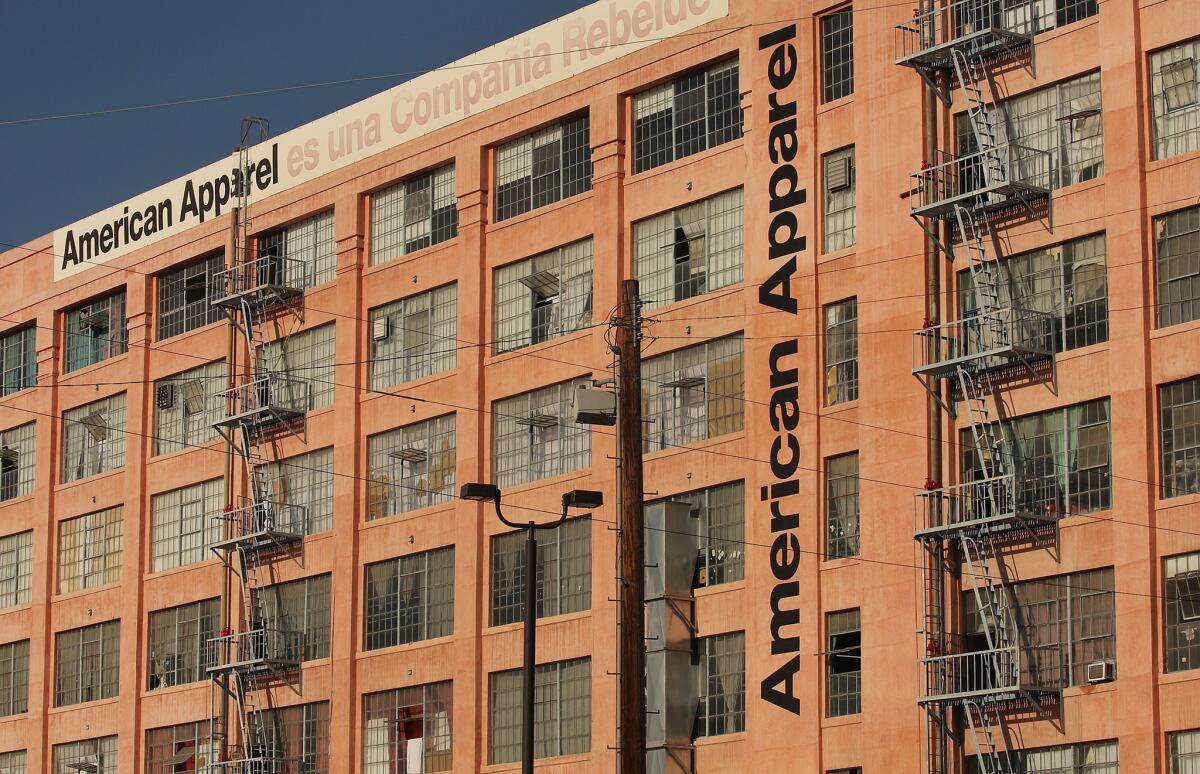American Apparel files for bankruptcy again and agrees to sell its brand to Gildan

- Share via
Reporting from Washington — With its second bankruptcy filing in a little more than a year and an agreement to sell its brand to a Canadian firm, American Apparel Inc.’s tumultuous corporate history is close to being sewn up.
“This is the end of American Apparel as we know it,” said Lloyd Greif, chief executive of Los Angeles investment banking firm Greif & Co.
For the record:
7:06 p.m. Jan. 18, 2025An earlier version of this article spelled the name of American Apparel’s founder and former chief executive, Dov Charney, as Dov Chaney.
“It’s not the end of the brand,” he predicted. “But it’s the end of American Apparel as a manufacturing and retail entity.”
American Apparel, which touted its “Made in the USA” T-shirts and other clothing with edgy ads, filed for bankruptcy protection Monday and announced it had reached an agreement to sell the brand’s intellectual property rights and some other assets to Montreal’s Gildan Activewear Inc. for $66 million.
Gildan has no interest in American Apparel’s 110 retail stores in 28 U.S. states and 83 others around the world. But court filings said Gildan “has negotiated for the opportunity to maintain all or a portion of” American Apparel’s Los Angeles manufacturing, distribution and warehouse operations.
“We feel like ‘made in America’ is an inherent part of that brand,” said Garry Bell, Gildan’s vice president of corporate communications and marketing. “It is our intent to continue that focus.”
Other companies also will get to bid for American Apparel’s intellectual property rights and other assets as part of the bankruptcy process.
American Apparel has about 5,900 employees worldwide but would not detail how many are in the Los Angeles area, where its headquarters is located and the company does all of its manufacturing. It has facilities in downtown Los Angeles, Garden Grove, La Mirada and South Gate.
Greif doesn’t think that Gildan or another buyer would continue manufacturing in Los Angeles, where the minimum wage is set to increase to $15 an hour by 2020.
“California is a very high-cost place to have people who cut and sew,” he said. “If you want to be American-made apparel, there’s 50 states in the union you can make it. Why make it in the most expensive state?”
American Apparel rose to prominence under founder Dov Charney, who started the company in his dorm room at Tufts University.
But the once high-flying firm struggled after the 2008-09 Wall Street market crash, was heavily in debt and went years without posting a net profit. Charney had been making slow progress in turning around the company when he was ousted in 2014 after an investigation into alleged inappropriate behavior with employees and misuse of company funds.
Troubles continued after American Apparel emerged from bankruptcy last winter. And some recent turmoil, including another leadership change, led to rumors of a sale.
Charney said Monday that there was “a dramatic deterioration” in the company’s fortunes after he was forced out as chairman and chief executive. He is suing company officials and hedge fund Standard General for conspiring to push him out.
“This dropped like a ball of lead in the water,” he said of American Apparel’s fortunes after he left.
In a letter to employees Monday, the company’s chairman, Bradley Scher, said the bankruptcy and deal with Gildan were necessary to keep the brand afloat.
“We are confident that this decision is the best strategic move forward, in order to preserve the legacy of the American Apparel brand,” he wrote.
Although American Apparel reached a sales agreement with Gildan, the bankruptcy filing allows for an auction in which other buyers could make competing offers, including for American Apparel’s retail business, Scher wrote.
“Ultimately, we will be able to get the best deal done by requiring various other bidders to compete to buy our iconic brand,” Scher wrote.
Charney said Monday he might consider bidding if he found a financial backer to partner with, but that he would first need to assess American Apparel’s financial condition.
American Apparel filed for Chapter 11 protection at U.S. Bankruptcy Court in Delaware on Monday less than 10 months after a judge there approved a reorganization plan that took the company private. That plan, approved in January, wiped out much of the company’s debt and put the company under the ownership of its creditors.
Charney, whose ownership stake was wiped out in the earlier bankruptcy, tried to derail the restructuring plan and regain control of the company.
His effort was unsuccessful, but the new privately held company continued to struggle. It laid off hundreds of employees in the spring.
In September, Paula Schneider, the CEO brought in to turn around the company, announced she was leaving. She was replaced by general counsel Chelsea Grayson amid rumors American Apparel was looking for a buyer.
In the Monday filing with the bankruptcy court, American Apparel’s chief restructuring officer, Mark Weinsten, said the company’s turnaround plan failed.
“The company faced unfavorable market conditions that were more persistent and widespread than the debtors anticipated” when they emerged from the first bankruptcy, he said.
Since then, the company’s sales have dropped 32.7% year over year. In 2015, it had net sales of $278 million at its worldwide retail stores and $52 million online, according to court filings.
Greif said the timing of the bankruptcy showed the situation was desperate.
“When it’s a retailer and it files bankruptcy before the holidays, that means there was no hope,” he said.
“It was a brand at one time with $600 million in [annual] revenues. It’s half of that now,” Greif said. “It has fallen mightily and it continues to pick up speed on a downhill slope.”
American Apparel has secured $30 million in bankruptcy financing and needs court approval for $10 million to keep the company operating, according to court filings. Weinsten cited $3 million in payroll obligations coming due next week.
In announcing its agreement with American Apparel, Gildan said the company is “a highly recognized brand among consumers” and that it would separately buy American Apparel inventory “to ensure a seamless supply of goods” as the brand is integrated into its offerings.
Follow @JimPuzzanghera on Twitter
UPDATES:
3:45 p.m.: This article has been updated throughout with new details. Comments were added from Lloyd Greif of Greif & Co. and Garry Bell, Gildan Activewear Inc.’s vice president of corporate communications.
12:30 p.m.: This article has been updated with details from court filings, comments from American Apparel founder Dov Charney and additional comments from Chairman Bradley Scher.
9:35 a.m.: This article has been updated with comments from American Apparel spokeswoman Arielle Patrick and from a letter by Chairman Bradley Scher.
This article was originally published at 8 a.m.
More to Read
Inside the business of entertainment
The Wide Shot brings you news, analysis and insights on everything from streaming wars to production — and what it all means for the future.
You may occasionally receive promotional content from the Los Angeles Times.











